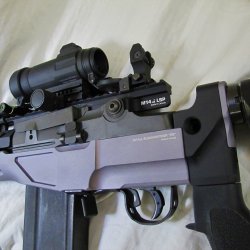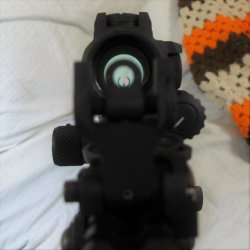^ I'm in vision science - the nerdy basic science part of that  - and yes, there's some actual, quantifiable differences - but......
- and yes, there's some actual, quantifiable differences - but......
^ This is really both the long and short of it.
Simply because of the objective and subjective differences in how each of us "sees" as a unique person, really, the only way to truly be able to tell if one or another is better/worse for you is to get your eyes behind it.
And this isn't just holding the sight in your hand (hopefully at least extended to the approximate distance at which you'll be looking through the optic) at the store, looking across the building - much like test-driving a car, for many, it's not until you actually get out on the road that the more subtle differences come to-light. A more experienced driver may be able to sit in a car on the showroom floor and be able to discern certain "fit" issues: just as more experienced shooters can often fondle a gun off the display case at their LGS -if not also dry-fire it- and at least have some idea of how their first live shot may print downrange. But particularly for those who lack that base of experience and knowledge, until they actually are shooting with that sight, much of it can remain a mystery, no matter how in-depth the explanations of printed words or in video.
I tell folks to not be afraid of asking other shooters at the rate or in classes about their gear, and to even see if they'd be willing to let you take a few shots from it - particularly if you offer to pay for the ammo or trade for time/rounds on your gun.
Getting hands-on (er...eyes behind?) is really the best way.
You can read all day long but until you actual get to look through one and use it will you know if it works for you and be able to say, "this is pretty cool."
^ This is really both the long and short of it.
Simply because of the objective and subjective differences in how each of us "sees" as a unique person, really, the only way to truly be able to tell if one or another is better/worse for you is to get your eyes behind it.
And this isn't just holding the sight in your hand (hopefully at least extended to the approximate distance at which you'll be looking through the optic) at the store, looking across the building - much like test-driving a car, for many, it's not until you actually get out on the road that the more subtle differences come to-light. A more experienced driver may be able to sit in a car on the showroom floor and be able to discern certain "fit" issues: just as more experienced shooters can often fondle a gun off the display case at their LGS -if not also dry-fire it- and at least have some idea of how their first live shot may print downrange. But particularly for those who lack that base of experience and knowledge, until they actually are shooting with that sight, much of it can remain a mystery, no matter how in-depth the explanations of printed words or in video.
I tell folks to not be afraid of asking other shooters at the rate or in classes about their gear, and to even see if they'd be willing to let you take a few shots from it - particularly if you offer to pay for the ammo or trade for time/rounds on your gun.
Getting hands-on (er...eyes behind?) is really the best way.


